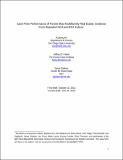| dc.contributor.author | An, Xudong | |
| dc.contributor.author | Fisher, Jeffrey D. | |
| dc.contributor.author | Geltner, David M. | |
| dc.date.accessioned | 2016-07-14T19:50:56Z | |
| dc.date.available | 2016-07-14T19:50:56Z | |
| dc.date.issued | 2015-08 | |
| dc.identifier.issn | 0895-5638 | |
| dc.identifier.issn | 1573-045X | |
| dc.identifier.uri | http://hdl.handle.net/1721.1/103612 | |
| dc.description.abstract | Using a unique dataset of building operating statements from Fannie Mae, we develop repeated measures regression (RMR) indices for NOI, EGI and PGI to track the cash flow performance of Fannie Mae-financed multifamily real estate. Our three-stage RMR estimate shows an average NOI growth of about 1.8 % during 1993–2011, which is lower than inflation rate and significantly lower than what is usually perceived by investors. Based on the RMR estimates, we find that the whole portfolio of Fannie Mae multifamily properties outperforms NCREIF multifamily properties in NOI growth, especially during the 2000–2001 recession and the Great Recession, which helps explain the superior performance of Fannie Mae multifamily mortgage loans during the recent crisis. In the cross section, multifamily properties in supply-constrained areas have substantially larger NOI growth. Workforce housing performs better than low-income housing even after we control for locational differences and property features. We do not find a size effect in NOI growth once we control for supply constraints. We also find EGI growth to be much less volatile than NOI growth, which implies that changes in operating expenses are the main driving factor of the cyclicality of NOI. Operating expenses also tend to be pro-cyclical – they grow faster during recessions. EGI growth (decline) leads PGI growth (decline), which supports the stock-flow model of rental adjustment where vacancy changes before rent. From a methodological perspective, we find that the conventional methods such as simple average and weighted average over-estimate multifamily NOI growth, likely due to significant sample selection bias and outlier influence. In contrast, the RMR indices control for changes in property quality and are much more robust in the presence of data errors and outliers. | en_US |
| dc.publisher | Springer US | en_US |
| dc.relation.isversionof | http://dx.doi.org/10.1007/s11146-015-9521-4 | en_US |
| dc.rights | Creative Commons Attribution-Noncommercial-Share Alike | en_US |
| dc.rights.uri | http://creativecommons.org/licenses/by-nc-sa/4.0/ | en_US |
| dc.source | Springer US | en_US |
| dc.title | Cash Flow Performance of Fannie Mae Multifamily Real Estate: Evidence from Repeated NOI and EGI Indices | en_US |
| dc.type | Article | en_US |
| dc.identifier.citation | An, Xudong, Jeffrey D. Fisher, and David Geltner. “Cash Flow Performance of Fannie Mae Multifamily Real Estate: Evidence from Repeated NOI and EGI Indices.” J Real Estate Finan Econ 52, no. 4 (August 19, 2015): 512–542. | en_US |
| dc.contributor.department | Massachusetts Institute of Technology. Center for Real Estate | en_US |
| dc.contributor.department | Massachusetts Institute of Technology. Department of Urban Studies and Planning | en_US |
| dc.contributor.mitauthor | Geltner, David M. | en_US |
| dc.relation.journal | The Journal of Real Estate Finance and Economics | en_US |
| dc.eprint.version | Author's final manuscript | en_US |
| dc.type.uri | http://purl.org/eprint/type/JournalArticle | en_US |
| eprint.status | http://purl.org/eprint/status/PeerReviewed | en_US |
| dc.date.updated | 2016-05-23T12:14:48Z | |
| dc.language.rfc3066 | en | |
| dc.rights.holder | Springer Science+Business Media New York | |
| dspace.orderedauthors | An, Xudong; Fisher, Jeffrey D.; Geltner, David | en_US |
| dspace.embargo.terms | N | en |
| dc.identifier.orcid | https://orcid.org/0000-0002-1024-7555 | |
| mit.license | OPEN_ACCESS_POLICY | en_US |
| mit.metadata.status | Complete | |
